 Back to the Be Inspired Blog
Back to the Be Inspired Blog

Growing Cucumbers: The Best Varieties and Pickle Recipes
A cucumber plant is an easy and impressive addition to your garden. Fairly low-maintenance and easy to grow, they are a fan favorite vegetable and one of the only ones to be labeled “refreshing.” When you’re growing cucumbers, you’ll get to enjoy them delicious fresh off the vine, sliced and served with dip, tossed into salads or on top of sandwiches.
What’s Best For Growing Cucumbers In Your Space?
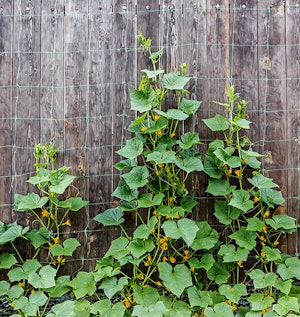
Cucumber plants grow in two forms: vines and bushes. Vines need space to spread out along the ground or climb up a trellis, while bush types form a more compact plant better suited to containers and small gardens. Generally, vining cucumber will yield more fruit throughout the growing season, but you can get a bigger harvest from bush varieties by planting several crops two weeks apart.
Cucumbers need warm, fertile soil that allows them to put down a deep root system. If you’re growing in the ground, plant seedlings 36 to 60 inches apart (depending on their variety). Lay down a thick layer of mulch made up of straw or chopped leaves shortly after planting. The rough terrain will not only be uncomfortable for slugs and other garden pests that would munch on your cucumbers, but it will also help keep the fruit clean and relatively dry.
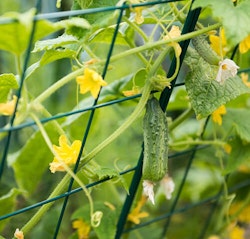
If you can, trellis your cucumbers. For vines that will train on a trellis, plants only need to be 12 inches apart. A 12- to 18-inch diameter cage made of wire fencing or hog wire will support two or three vines each. This will help the vines to grow upwards, keeping the fruit clean and supporting its weight.
Cucumbers grow fast and don’t demand a lot of care. The most important factor is to keep the soil consistently moist with at least an inch of water per week, and more if the temperatures are above normal. Inadequate or inconsistent moisture causes oddly shaped and poor-tasting fruit. If possible, water your cucumbers with a soaker hose or drip irrigation to keep the leaves dry and prevent leaf diseases that can ruin the plant.
Troubleshooting Common Problems When Growing Cucumbers
Even the greenest of thumbs run into the occasional brown spot. Here are a couple of the most common problems you might encounter when growing cucumbers in your garden.
Your Cucumbers Don’t Grow Fruit
If your cucumber vines bloom but don’t fruit, something is probably interfering with pollination. First, make sure that you see both male and female blooms. Male blooms usually appear first and then drop off, so don’t be alarmed if this happens.
Within a week or two female flowers will also appear, each with a small cucumber-shaped swelling at the base which will eventually become the fruit. If you don’t see that happening, you may need to do some hand pollination. Simply rub a brush or cotton swab around the inside of each of the flowers to spread the pollen.
Common Pests That Love Cucumbers
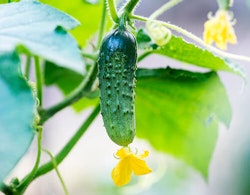
There are several common pests that will bother your growing cucumbers.
- Squash bugs may attack seedlings while slugs enjoy the ripening fruit.
- Aphids can colonize leaves and buds.
- Cucumber beetles chew holes in leaves and flowers that scar stems and fruits, and can also spread a disease that causes the plants to wild and die.
Laying down a thick layer of mulch and straw will help to keep many of these common pests at bay. You can also treat the plants by spraying with a mild solution of water and soap to remove them. Remember to wash the fruit thoroughly before eating.
Harvesting and Storing Your Cucumbers
Pick your cucumbers as soon as they are big enough to use. Once the fruit appears, check them daily – you might be surprised by just how quickly they can grow, and an oversized cucumber will be bitter. Harvesting the fruit also encourages the vine to produce more, so don’t be shy about picking them to enjoy right away.
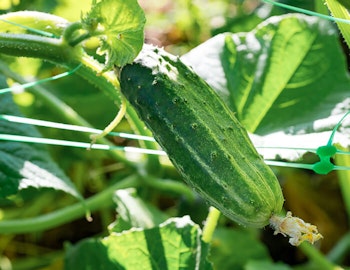
To remove the fruit from the vine, use a knife or clippers, cutting the stem about an inch above the fruit. Do not use your hands to pull or twist them off as this can damage the vine. If you see the fruit beginning to turn yellow at the bottom (blossom end) it is overripe and should be removed immediately.
Once harvested, cucumbers should be eaten immediately for the best flavor, however they will keep in the refrigerator for seven to 10 days. If you don’t eat the entire cucumber at once, cover the cut end of the remaining fruit in plastic wrap to prevent dehydration.
The Best Cucumber Varieties To Grow In Our Area
The majority of the South Bay Area falls into the USDA hardiness zone 9, which means it best supports plants that are hardy down to 25 degrees. Here are some of the best cucumber varieties that grow well in our argea and are perfect for slicing and pickling.
Slicing
- Dasher II – This dark green hybrid has a strong resistance to most diseases. It produces white-spined fruit about 8.5 inches long and is ready to harvest in 55 days. This variety is best grown on a fence or trellis.
- Sweet Success – This is a burpless hybrid, which means the skin is thinner and sweeter than a traditional cucumber. The fruit will grow to 12-14 inches long and is ready to harvest in 55 days. This variety should be staked or grown on a trellis.
- Salad Bush – This is a compact variety bred to be grown in a container. It produces dark green fruit about 8 inches long that are ready to harvest in 55 days.
- Straight Eight – This heirloom variety produces fruit 8 inches long with sweet, fine-grained flesh. It is known as a high-yield plant in home gardens and ready to harvest in 65 days. This variety has long, trailing vines that do best with support from a trellis or cage.
- Spacemaster 80 – This variety grows 3-foot vines and is suitable for growing in containers. The fruit it produces is 7 to 8 inches long and ready to harvest in 60 days.
- Burpless #26 – This hybrid vine produces fruit that will grow to 12 inches long, but have better flavor if picked between 8 and 10 inches, about 50 days from planting. This variety does best on a trellis or cage and will produce consistently during the growing season.
Pickling
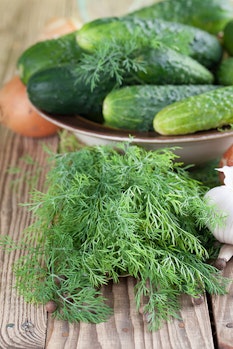
- Calypso – This dark green variety grows short, thick fruit about three inches long that is ready to harvest in 50 days. The vines do best with some support from a trellis or cage.
- Little Leaf – This vine variety needs room to spread out, with smaller than normal leaves which make it easy to spot fruit when harvesting. The cucumbers reach 3 to 5 inches in length and are ready to harvest in 60 days.
- National Pickling – Good for dill pickles, these vines can either grow on the ground or with support. This variety produces fruit about 6 inches in length with thin skin that are ready to harvest in 50 days.
- Carolina – This variety grows quickly, reaching maturity in just 50 days. The fruit grows to 3 inches long with a noticeable white spine. Offer support with a trellis or cage to maximize yield.
- County Fair – This variety grows two-foot vines very quickly, with fruit ready to harvest at 52 days. Cucumbers will reach 3 inches long and are burpless and seed-free if kept away from other varieties.
When Your Garden Gives You Cucumbers, Make Pickles
Pickling might sound intimidating to the uninitiated, but it’s a deceptively simple process that you can do in even the smallest kitchen. Here are three of the top recipes from the experts at Bon Appetit.
Classic Dill Pickles
Ingredients
- 2 lb. cucumbers, quartered
- 10 large sprigs dill
- 1 cup white distilled vinegar
- 2 Tbsp. kosher salt
- 2 tsp. sugar
- 2 tsp. black peppercorns
- 2 tsp. caraway seeds
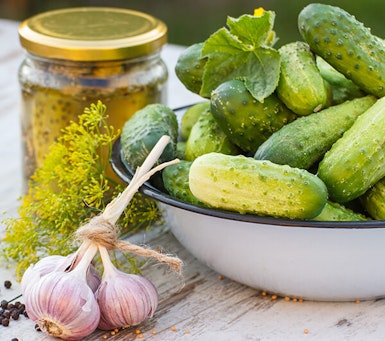
Instructions
Divide cucumbers and dill between jars. Bring vinegar, salt, sugar, peppercorns, caraway seeds, and 2 cups water to a boil in a small saucepan, stirring to dissolve salt and sugar. Pour hot brine into jars, dividing evenly, and cover. Let cool, then chill. Allow four to six weeks to cure and develop flavor before that.
Bread and Butter Pickles
Ingredients (yields one jar)
- 2 burpless cucumbers, 3-5 inches long
- 1 small onion, thinly sliced
- 2 jalapeños, thinly sliced
- 4 large dill sprigs
- 2 Tbsp. coriander seeds
- 2 Tbsp. mustard seeds
- 2 tsp. celery salt
- 2 cups distilled white vinegar
- 1 cup sugar
- 2 Tbsp. kosher salt
Instructions
Pack cucumber, onion, jalapeños, dill sprigs, coriander seeds, mustard seeds, and celery salt into a jar. Bring vinegar, sugar, and salt to a boil in a medium saucepan, stirring to dissolve sugar and salt. Carefully pour mixture into the jar, filling all the way to the top. Seal jar and chill at least 12 hours and up to 1 week.
Sweet Pickles
Ingredients
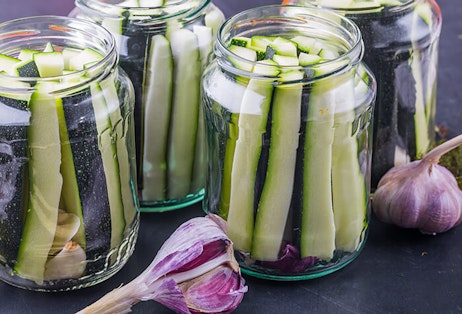
- 2 lbs. medium pickling cucumbers, scrubbed and cut into 1/4-inch-thick rounds
- 1 small sweet onion, thinly sliced
- 1 large bunch dill, coarsely chopped (stems included)
- 1 Tbsp. yellow mustard seeds
- 2 tsp. whole white peppercorns
- 1 1/2 cups apple cider vinegar
- 1 cup water
- 1 cup sugar
- 3 Tbsp. coarse kosher salt
- 2 tsp. dill seeds
Instructions
Divide sliced onion between two 1-quart wide-mouth glass jars. Pack the cucumber slices horizontally in the jars and top each jar with dill.
Using a mortar and pestle or resealable plastic bag and mallet, crush mustard seeds and peppercorns together. Place crushed spices in a medium saucepan. Add vinegar, 1 cup water, sugar, coarse salt, and dill seeds. Bring mixture to boil over medium-high heat, stirring until sugar dissolves.
Ladle mixture evenly over cucumbers. Leave jars uncovered and chill 24 hours.
Ask The SummerWinds Experts About Growing Cucumbers
Need a little extra advice about your cucumber growing setup and varieties? Let the experts at SummerWinds answer your questions! We’re happy to share tips on preparing your garden or picking out the perfect planter. Visit us at any one of our South Bay Area locations.
About SummerWinds Nursery: SummerWinds Garden Centers is a leading high-end retailer of garden and nursery products. Headquartered in Boise, Idaho, SummerWinds operates retail nurseries in the greater Phoenix, Arizona area, and in Silicon Valley, California, making it one of the largest independent retail nursery companies in the west. SummerWinds appeals to both the serious and casual gardeners, with a broad selection of premium gardening products and a friendly and knowledgeable staff.

